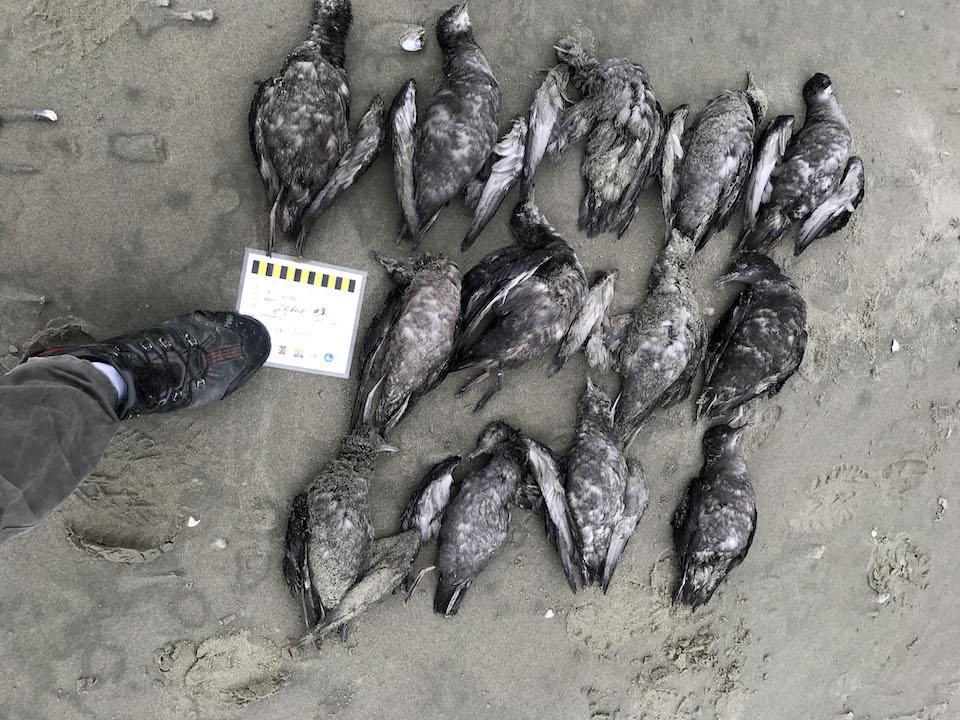
Short-tailed Shearwaters, Ikpek Lagoon, Bering Land Bridge National Preserve/NPS, Jason Tucker
Thousands of seabirds have died mysteriously this summer in the northern Bering and Chukchi seas, including near Bering Land Bridge National Preserve, according to the National Park Service.
From late June to early August, thousands of Short-tailed Shearwaters were reported dead and washing up on beaches in the Bristol Bay region, or observed weak and attempting to feed from salmon gillnets in inland waters. By mid-August, the shearwater die-off had extended north, in smaller numbers but widespread locations, into the northern Bering and Chukchi seas along the coasts of Alaska and the Chukotka Peninsula of Russia. Puffins, murres, and auklets are also being reported, but at much lower numbers than shearwaters.
Additionally, live Short-tailed Shearwaters have been observed in large numbers this August in the Gulf of Alaska, along the coasts of Glacier Bay and Kenai Fjords national parks, and bays of Kodiak Island. It is unusual to see this species in high abundance in these areas, as it is typically offshore and comes from the Southern Hemisphere to forage in the Bering and Chukchi seas during the summer and fall.
Historically, seabird die-offs have occurred occasionally in Alaska; however, large die-off events have occurred each year since 2015. Consistently, dead birds examined from the Bering and Chukchi seas during these recent die-offs were determined to have died due to starvation. Seabird carcasses from the 2019 die-off events were collected from multiple locations and sent to the U.S. Geological Survey National Wildlife Health Center for examination and testing. Initial results indicate starvation as the cause of death for most locations.
However, in southeast Alaska, exposure to saxitoxin (a biotoxin associated with paralytic shellfish poisoning) was linked in June to a localized die off of breeding Arctic Terns. Analyses of tissue samples for harmful algal bloom toxins are on-going and results will be shared as they become available. To date there has been no evidence of disease.

It is important to continue to track this event as it unfolds. The USFWS and NPS are coordinating efforts with local communities and other agencies. The public is requested to report observations of sick or dead birds to USFWS at 1-866-527-3358, or to local regional contacts listed in the USFWS fact sheet distributed in August 2019.
Report observations of sick or dead birds to regional partners:
*North Slope: Taqulik Hepa (907) 852-0350
* Northwest Arctic: Cyrus Harris (907) 442- 7914 Bering Strait Region: Brandon Ahmasuk (907) 443-4265 or Gay Sheffield (907) 434- 1149
* Yukon-Kuskokwim Delta: Jennifer Hooper (907) 543-7470
* Bristol Bay: Gayla Hoseth (907) 842-6252
* Pribilof Islands: Lauren Divine (907) 891- 3031 Unalaska: Melissa Good (907) 581-1876
* Aleutians: Karen Pletnikoff (907) 222-4286
* Or report by phone or email to the USFWS: 1-866-527-3358 or [email protected]
Information to include:
Location, Time and Date observed
Type and Number of birds (counted or estimated)
Photos of sick/dead birds
Videos of any unusual behavior (approachable, drooping head and/or wings)
The National Park Service does not recommend people attempt to capture or rescue birds that are still alive. They also request that people do not collect dead birds without prior training or collaboration with the USFWS.



Add comment